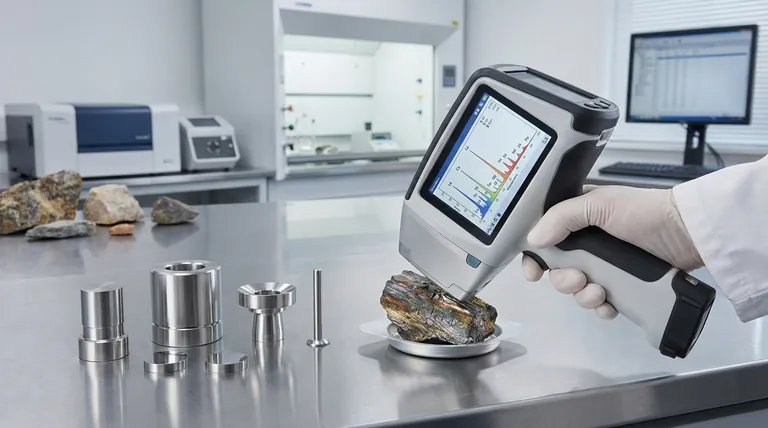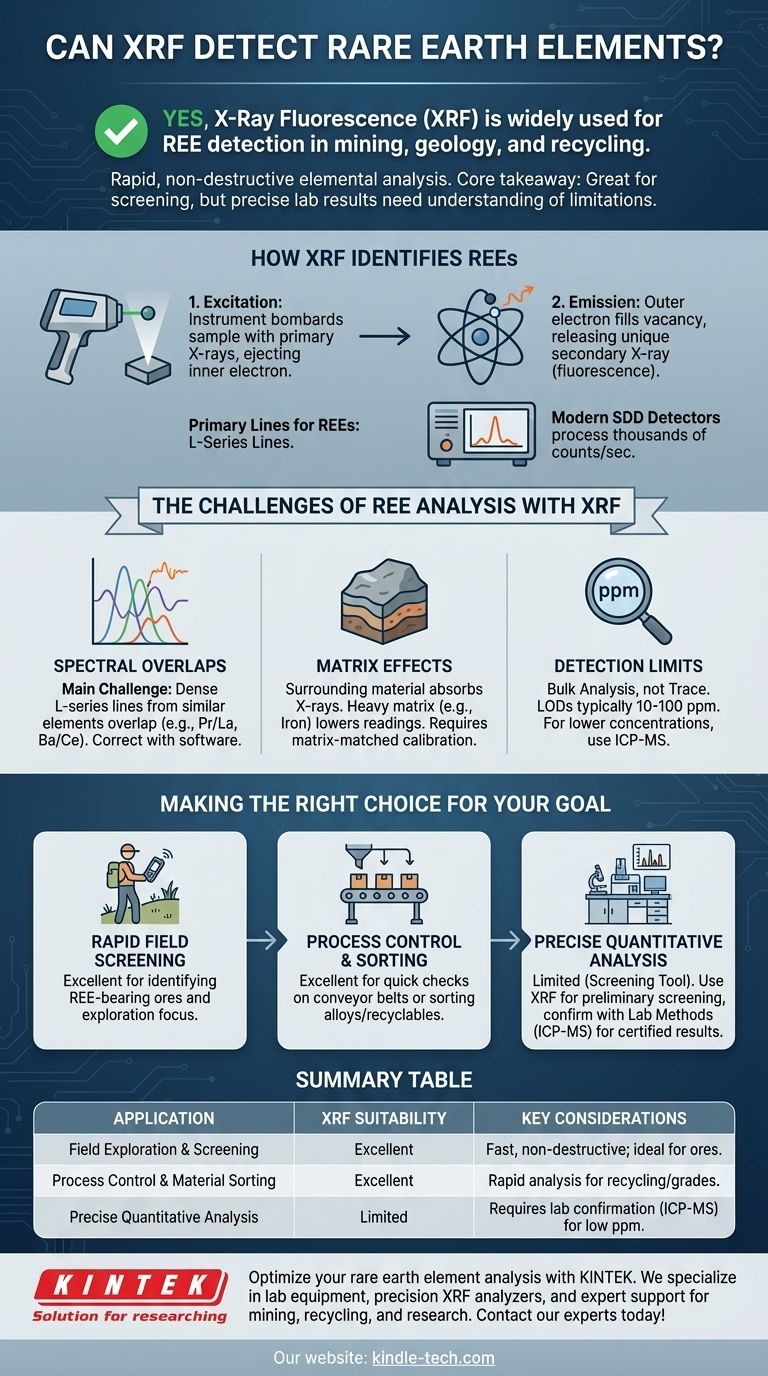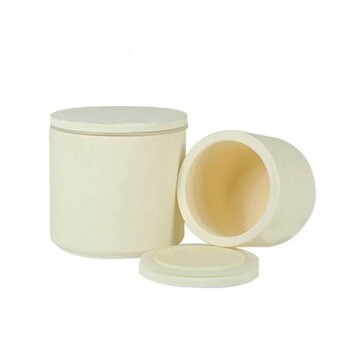Yes, X-Ray Fluorescence (XRF) is a widely used and effective technology for detecting rare earth elements (REEs). It is a standard method in mining exploration, geology, and recycling for providing rapid, non-destructive elemental analysis. However, the effectiveness and accuracy of the analysis depend heavily on the type of XRF instrument used, the specific REEs being targeted, and the complexity of the material being scanned.
The core takeaway is that while XRF is an indispensable tool for the rapid, semi-quantitative screening of REEs, achieving precise, laboratory-grade results requires a deep understanding of its inherent limitations—particularly spectral peak overlaps and matrix effects—and often necessitates confirmation with other analytical methods.

How XRF Identifies Rare Earth Elements
The Principle of X-ray Fluorescence
At its core, XRF analysis is a two-step process. First, the instrument bombards a sample with high-energy primary X-rays. This energy excites the atoms within the sample, causing them to eject an electron from an inner orbital shell.
To regain stability, an electron from a higher-energy outer shell immediately drops down to fill the vacancy. This transition releases a specific amount of energy in the form of a secondary X-ray, which is the "fluorescence" that the instrument's detector measures.
REE Spectral Signatures
Crucially, the energy of this secondary X-ray is unique to the element from which it was emitted. Each rare earth element has a characteristic "fingerprint" or signature of X-ray energies.
The primary spectral lines used for identifying REEs are the L-series lines. This is because the K-series lines for these heavy elements require extremely high energy to excite, often beyond the capability of standard XRF equipment.
The Role of Modern Detectors
Modern XRF analyzers, particularly portable units, use sophisticated Silicon Drift Detectors (SDDs). These detectors are capable of processing thousands of X-ray counts per second and have the resolution needed to distinguish between the often-crowded L-series lines of the various REEs.
The Practical Challenges of REE Analysis with XRF
While the principle is straightforward, real-world REE analysis presents significant challenges that you must understand to interpret your data correctly.
The Problem of Spectral Overlaps
This is the single greatest challenge in XRF analysis of REEs. The periodic table is dense with elements in this region, and their L-series emission lines are numerous and often very close to one another.
This creates significant peak overlaps, where the signal from one element interferes with or is mistaken for the signal of another. For example, the Lα line of praseodymium (Pr) can overlap with the Lβ line of lanthanum (La), and barium (Ba) lines can interfere with cerium (Ce). Correcting for these overlaps requires sophisticated software and careful calibration.
Light vs. Heavy REEs
XRF is generally more sensitive to Heavy REEs (HREEs) like gadolinium (Gd) and yttrium (Y) than it is to Light REEs (LREEs) like lanthanum (La) and cerium (Ce).
The X-rays emitted by LREEs have lower energy. These low-energy photons are more easily absorbed by the surrounding sample material (the matrix) and even by the air between the sample and the detector, weakening their signal.
Matrix Effects
The composition of the material surrounding the REEs has a major impact on the results. This is known as the matrix effect.
A heavy matrix, such as one rich in iron or lead, can absorb the fluorescent X-rays from the REEs, leading to an artificially low reading. Conversely, a light matrix, like silica, will have less of an effect. Accurate quantification requires that your calibration standards closely match the matrix of your unknown samples.
Detection Limits
XRF is a bulk analysis technique, not a trace analysis method. For REEs, the limits of detection (LODs) for portable XRF are typically in the range of 10 to 100 parts per million (ppm) under ideal conditions. For precise measurement of lower concentrations, you must turn to lab-based methods like ICP-MS.
Making the Right Choice for Your Goal
The right approach depends entirely on your objective. XRF is not a single solution but a versatile tool with different applications.
- If your primary focus is rapid field screening or geological exploration: A handheld XRF is unparalleled. It allows you to identify REE-bearing ores and make immediate decisions on where to focus further investigation.
- If your primary focus is process control or material sorting (e.g., recycling): Handheld XRF provides the speed needed to check material grades on a conveyor belt or sort alloys and electronic waste containing REEs.
- If your primary focus is precise, quantitative analysis for reporting or research: Use XRF as a preliminary screening tool, but rely on lab-based methods like ICP-MS (Inductively Coupled Plasma Mass Spectrometry) for final, certifiable results, especially for low concentrations.
Ultimately, using XRF effectively for rare earth elements means leveraging its strengths for speed and accessibility while respecting its limitations in precision and sensitivity.
Summary Table:
| Application | XRF Suitability | Key Considerations |
|---|---|---|
| Field Exploration & Screening | Excellent | Fast, non-destructive; ideal for identifying REE-bearing ores. |
| Process Control & Material Sorting | Excellent | Rapid analysis for recycling and grade verification. |
| Precise Quantitative Analysis | Limited (Screening Tool) | Requires confirmation with lab methods like ICP-MS for low concentrations. |
Optimize your rare earth element analysis with the right equipment. KINTEK specializes in lab equipment and consumables, serving laboratory needs with precision XRF analyzers and expert support. Whether you're in mining exploration, recycling, or research, our solutions deliver rapid, reliable results. Contact our experts today to find the perfect XRF tool for your specific REE detection challenges!
Visual Guide

Related Products
- XRF Boric Acid Lab Powder Pellet Pressing Mold for Laboratory Use
- Laboratory Jar Ball Mill with Alumina Zirconia Grinding Jar and Balls
- Optical Window Glass Substrate Wafer Barium Fluoride BaF2 Substrate Window
- Optical Window Glass Substrate Wafer CaF2 Substrate Window Lens
- Assemble Lab Cylindrical Press Mold
People Also Ask
- What are pellet dies made of? Choose the Right Material for Accurate XRF Analysis
- How do you make XRF pellets? A 4-Step Guide to Flawless Sample Preparation
- What is the lifespan of a mold? It's Immortal Unless You Control Moisture
- What are the samples for XRF analysis? A Guide to Preparing Solids, Powders, and Liquids
- What is the difference between EDS and XRF? EDS for Microanalysis, XRF for Bulk Analysis


















